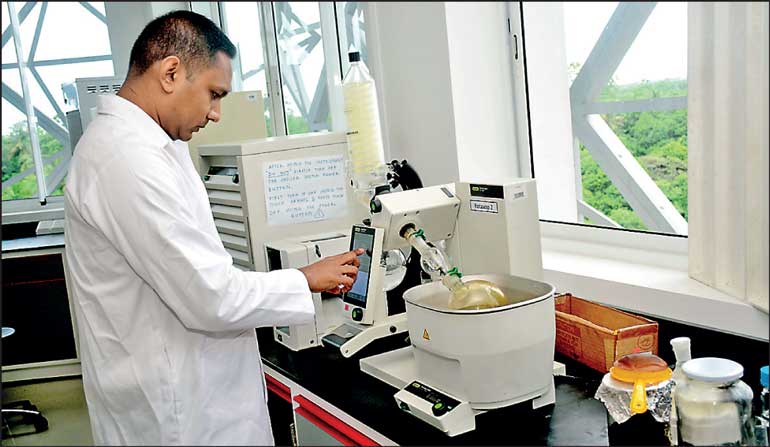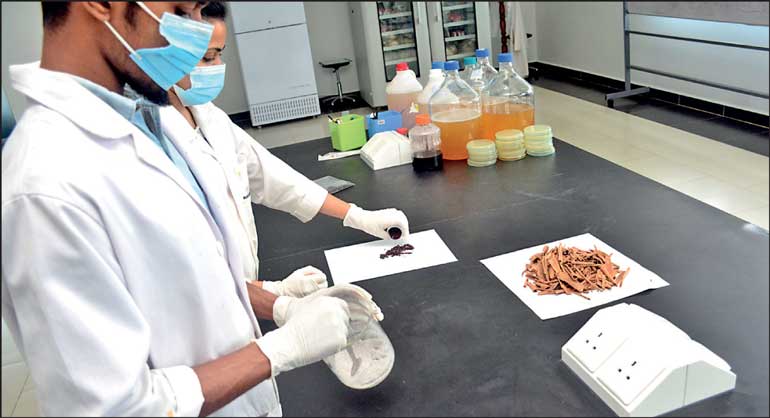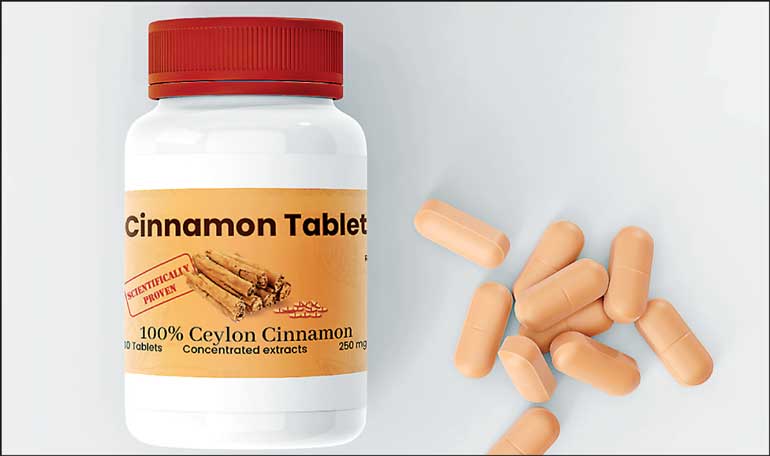Sunday Jan 11, 2026
Sunday Jan 11, 2026
Tuesday, 13 June 2023 00:00 - - {{hitsCtrl.values.hits}}

SLINTEC Research Fellow Dr. Wasantha Lankathilaka in one of SLINTEC’s labs
Sri Lanka is a global hotspot for diabetes today, having the highest diabetes prevalence in South Asia. Diabetes is a growing cause of global mortality and morbidity and a driver of healthcare costs
By Randima Attygalle
The Sri Lanka Institute of Nanotechnology (SLINTEC) located at the Nanotechnology and Science Park in Pitipana, Homagama, has developed a cinnamon tablet which is envisaged to be a ‘value-addition’ to the management of diabetes.
The sugar-controlling nutraceutical which has been formulated using cinnamon extracted from Ceylon Cinnamon bark is the first of its kind to be developed and is now awaiting clinical trials at the Department of Ayurveda.
Sri Lanka – a hotspot for diabetes
Sri Lanka is a global hotspot for diabetes today, having the highest diabetes prevalence in South Asia. Diabetes is a growing cause of global mortality and morbidity and a driver of healthcare costs. Global studies by the NCD Risk Factor Collaboration (NCD-RisC) and the International Diabetes Federation (IDF) indicate that diabetes in low and middle-income countries is increasing faster than in high-income countries with age-standardised prevalence in most developing regions higher than high-income countries. About 422 million people worldwide according to WHO, have diabetes, the majority living in low-and middle-income countries, and 1.5 million deaths are directly attributed to diabetes each year. Diabetes is a major cause of blindness, kidney failure, heart attacks, stroke and lower limb amputation.
The research paper titled, ‘Prevalence of diabetes and pre-diabetes in Sri Lanka: a new global hotspot – estimates from the Sri Lanka Health and Ageing Survey 2018/2019’ published in the British Medical Journal (BMJ) in February this year notes that ‘the high prevalence in Sri Lanka may be due to it being the most affluent nation in South Asia with the highest rates of overweight and obesity.’ The study confirms that adult prevalence of diabetes was 23% in Sri Lanka in 2019, and pre-diabetes was 30%, significantly higher than previous estimates have suggested. It also notes that most of the increase in diabetes and pre-diabetes prevalence with BMI occurs in Sri Lankan adults of ‘normal weight’ as classified using WHO’s Asian BMI cut-offs.
The findings of the study suggest that the Asian BMI cut-offs are not adequate to capture the increased risk of diabetes in Sri Lankans and probably in other South Asians and underline the increased risk of diabetes in these populations at low body weights. Moreover, the findings ‘reinforce the need for increased re- search to understand the drivers of increased diabetes risk in South Asian populations and for increased efforts to tackle diabetes and underlying drivers such as weight gain in Sri Lanka.’
The sugar-controlling nutraceutical which has been formulated using cinnamon extracted from Ceylon Cinnamon bark is the first of its kind to be developed and is now awaiting clinical trials at the Department of Ayurveda
Cinnamon tablet – a value-added supplement
In such a backdrop, SLINTEC’s cinnamon tablet is perceived to be reducing the Metformin intake by diabetes patients. “Although the world is moving away from Metformin to new classes of diabetes management drugs such as Gliptins, many developing and underdeveloped countries still depend on Metformin as it’s economical in price and is effective. Here at home, 90% of people take 500 mg of Metformin thrice a day. In this context we were thinking of coming up with a solution using something inherent to Sri Lanka which could reduce the Metformin intake and the result is the cinnamon pill which entails the healing properties of Ceylon Cinnamon,” says SLINTEC CEO and the Presidential Advisor on Scientific Affairs Dr. Vajera Perera.
He goes on to note that the product, however, is not a total solution for diabetes but adds value to the management of the disease which comes at an enormous health, social and economic cost. The testing of the product which has been carried out on a rat-model has proven to be lowering the sugar levels in the body.
Ceylon Cinnamon – a prized spice
The vitamin stores in the West sell a whole gamut of cinnamon products including pills. However, nearly all of such products contain cassia. Although it is a variety of cinnamon, cassia is inferior to Ceylon Cinnamon. Ceylon Cinnamon has historically been one of the most prized spices and its health properties are already well established and documented in world’s leading clinical and research journals. The SLINTEC’s cinnamon tablet is positioned to be different to other ‘similar products’ in the market, given its signature property of Ceylon Cinnamon, its efficacious effect and sophisticated manufacturing process on par with international standards, maintains SLINTEC’s CEO.

Ceylon Cinnamon’s goodness meets innovation

Cinnamon tablet of SLINTEC now awaiting clinical trials at the Department of Ayurveda
The pill which was being researched for the past 10 years, fuses the goodness and time-tested properties of our home-grown cinnamon with the latest sophisticated technology in a bid to bring out a very user-friendly supplement for those with diabetes, remarks SLINTEC’s Research Fellow Dr. Wasantha Lankathilaka. “Since the tablet contains endemic material and there is no prescription requirement involved, we need to get the approval of the Department of Ayurveda and possibly it needs to undergo another clinical trial with them as well and hopefully we will be able to launch the product commercially at the end of this year,” says the scientist, adding that the approval processes need to be fast-tracked if the tablet is to be commercially launched in the market as planned.
“The research has been a very rewarding one. The scientists involved received the best support from SLINTEC management and the board. We hope that the next phases of the process too will receive equal support from necessary authorities in the Ayurveda Department.”
A billion-dollar industry
SLINTEC was established in 2008 as a joint venture between the Government and the corporate sector to fill the much-required gap for research and development in Sri Lanka and to create a science and technology eco system in the country. Steered by a proactive management drawing from both the state and the private sector, SLINTEC comprises a board of corporate giants in the country. The process of marketing and commercialising the cinnamon tablet – its latest intellectual property, would most likely to be vested with one of the leading pharmaceutical players already on board with SLINTEC, says its CEO. Joint ventures are being contemplated at present, he says.
The market for the cinnamon tablet – both local and overseas, would be enormous, says Dr. Perera. “There are discussions taking place at the Health Ministry to administer Atorvastatin to those at the borderline of cholesterol as a prophylactic drug. Although cholesterol levels in some people may be normal, other factors such as smoking, diet and lack of exercise would predispose them to heart disease. The logic of administering Atorvastatin is to mitigate these other risk factors. We believe that the cinnamon tablet too could play a huge role as a prophylactic drug in diabetes control. If we can replace at least one dose of Metformin with the cinnamon tablet, then I think we have won,” says the scientist who goes on to say that SLINTEC is also exploring a potential export market for the product.
Ceylon Cinnamon has historically been one of the most prized spices and its health properties are already well established and documented in world’s leading clinical and research journals. The SLINTEC’s cinnamon tablet is positioned to be different to other ‘similar products’ in the market, given its signature property of Ceylon Cinnamon, its efficacious effect and sophisticated manufacturing process on par with international standards
To reap the optimum potential of our cinnamon, the industry too should be strengthened. Encouraging the cinnamon farmers to expand their cultivation through sharing of agricultural knowledge, offering relief on fertiliser, creating more employment opportunities within the industry and strengthening the supply chain and logistic support at ports and airports are among these
 To add more teeth to the local data on the pill’s efficacy, samples of the product have already been sent to the US for further evaluation using more sophisticated interventions. “Such endorsement would help us market the product in the US. Moreover, we are also looking at China and Taiwan as potential importers. However, it is imperative that we first have a strong foothold here at home,” Dr. Perera notes.
To add more teeth to the local data on the pill’s efficacy, samples of the product have already been sent to the US for further evaluation using more sophisticated interventions. “Such endorsement would help us market the product in the US. Moreover, we are also looking at China and Taiwan as potential importers. However, it is imperative that we first have a strong foothold here at home,” Dr. Perera notes.
Cinnamon’s true potential
The product as the scientist explains, is just one of the many value-added products Ceylon Cinnamon is capable of. “This type of experiments gives us clues about other domains in which cinnamon could bring out its true potential. In Mexican bars, Ceylon Cinnamon sticks sourced by leading exporters such as G.P De Silva and Sons are being rolled into toffee-like substance and are offered with drinks which add flavour to the beverage. This kind of value-added cinnamon products sell material worth of billion dollars in that part of the world.”
To reap the optimum potential of our cinnamon, the industry too should be strengthened. Encouraging the cinnamon farmers to expand their cultivation through sharing of agricultural knowledge, offering relief on fertiliser, creating more employment opportunities within the industry and strengthening the supply chain and logistic support at ports and airports are among these.
Calling for a culture of growing and competition, Dr. Perera says it is imperative to think beyond Sri Lanka. “Today our turmeric is very popular in counties such as France where it is chopped and added into the animal feed as turmeric has the inherent ability to kill fungus and bacteria. What we could do with our spices is endless for which we also need competition to push our limits and add value to the customer. I would like to see several companies coming forward to take the cinnamon pill’s initiative forward.”
Towards a culture of transformative innovation
In a setting where less than 1% GDP is spent on R and D, innovation of this kind is critical as alternative means, observes SLINTEC Head of Business Development Dr. Lakshitha Pahalagedara. SLINTEC’s cinnamon pill is also a reflection of the organisation’s commitment to transformative innovation, he says. SLINTEC’s business model allows them to seamlessly partner with clients, extending their expertise and dedicated RandD teams to help their clients design and test prototypes. With access to highly qualified scientists and engineers exposed to some of the most sophisticated systems, SLINTEC is today one of the best facilities here at home to conduct research into innovative technologies, helping business benefit from the research solutions.
In our other Asian counterparts such as China, India, Bangladesh and Vietnam, the chemical industry is very vibrant. Since we don’t have such a chemical industry, we need to depend on everything imported. Today some industries are moving out of Sri Lanka and it’s a serious situation. The ultimate solution is to use locally available raw materials and produce value-added products
Value-added exports
Moving towards a culture of value-added exports is means of bridging Sri Lanka’s gap between the imports and exports, points out Dr. Pahalagedara who cites SLINTEC’s latest cinnamon tablet as a fine example for this. “In our other Asian counterparts such as China, India, Bangladesh and Vietnam, the chemical industry is very vibrant. Since we don’t have such a chemical industry, we need to depend on everything imported. Today some industries are moving out of Sri Lanka and it’s a serious situation. The ultimate solution is to use locally available raw materials and produce value-added products. Having said that, we need to look at the value instead of the quantity. So even if we export lesser quantities, uniqueness of such products would generate higher profit margins,” maintains the scientist.

SLINTEC committed to creating a science and technology ecosystem in the country
Alluding to the example of the special facemask produced by SLINTEC during the height of the COVID-19 pandemic, he further remarks: “The censor of the facemask used graphene. We got a patent to convert graphite into graphene to produce the mask in a large scale. We have been historically exporting graphite for centuries but the future is to produce value-added high-tech products out of graphite. Our experience with the cinnamon tablet has been similar – we used something authentic to Sri Lanka and converted it to a sophisticated value-added product which the world at large would demand.”
SLINTEC’s business model allows them to seamlessly partner with clients, extending their expertise and dedicated RandD teams to help their clients design and test prototypes. With access to highly qualified scientists and engineers exposed to some of the most sophisticated systems, SLINTEC is today one of the best facilities here at home to conduct research into innovative technologies, helping business benefit from the research solutions
Moving towards manufacturing more value-added products from our natural resources would also attract more investors, says Dr. Pahalagedara. “We cannot wait for RandD to arrive here; we need to galvanise ourselves to promote innovation. At SLINTEC we are committed to this cause, bringing human resource, top scientists and state-of-the-art technology,” reflects the scientists who urges researchers, the Government and other stakeholders to become partners in this process of forging an innovative ecosystem in the country.
Pix by Upul Abayasekara